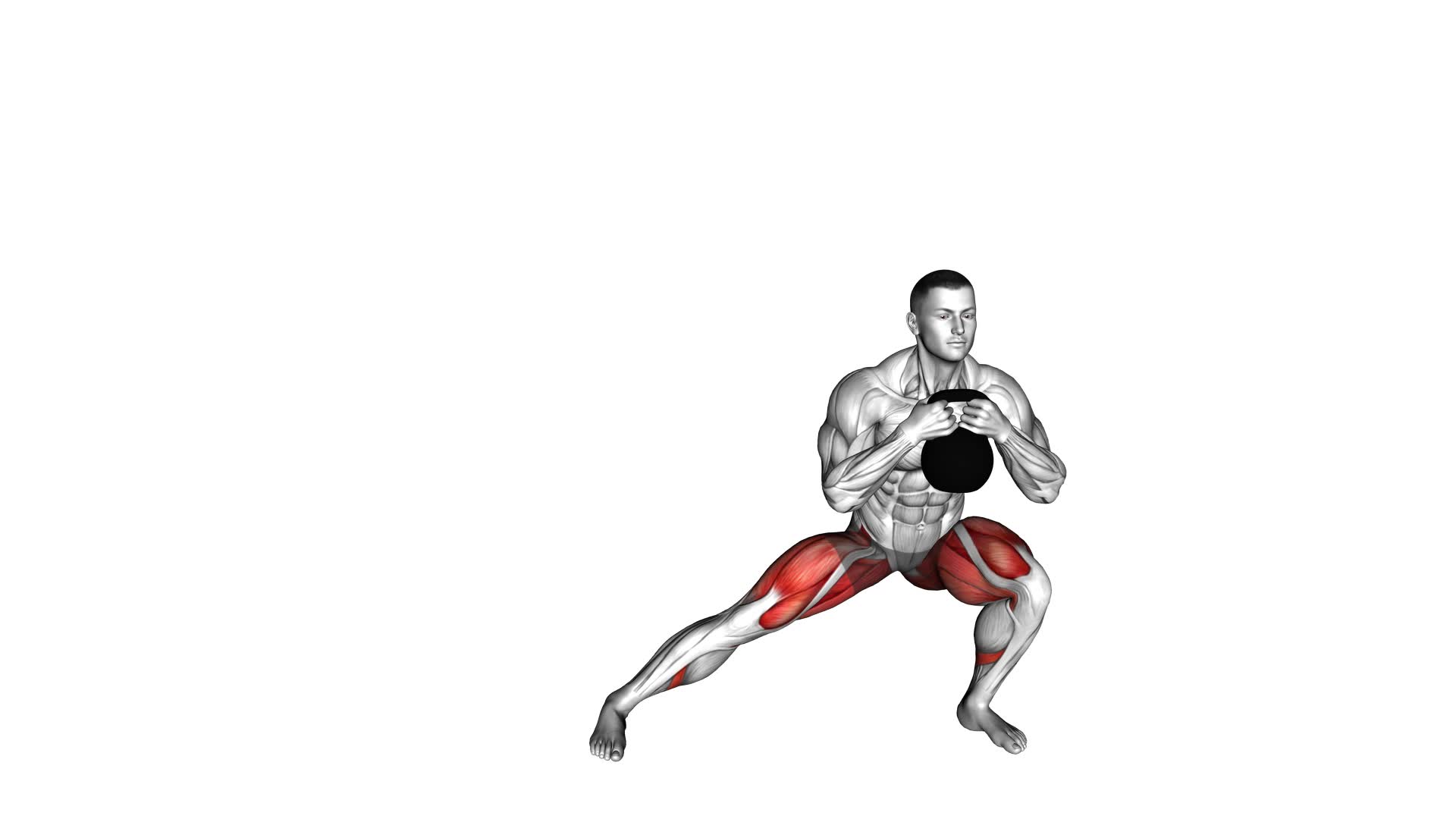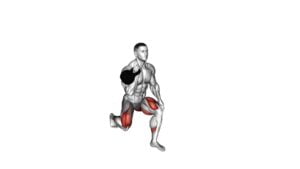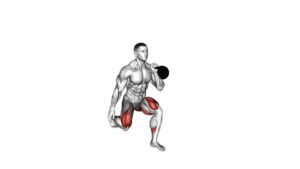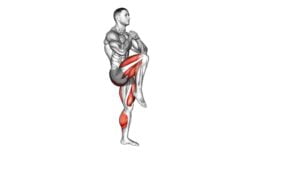Kettlebell Side Lunge (male) – Video Exercise Guide & Tips

Looking to strengthen your lower body and improve your flexibility? The kettlebell side lunge is a fantastic exercise to add to your routine.
Watch This Exercise Video
This video exercise guide will walk you through the proper form and technique, as well as provide tips to ensure a safe and effective workout.
Avoid common mistakes and learn variations and progressions to challenge yourself.
Get ready to feel the burn and see results with the kettlebell side lunge!
Key Takeaways
- The Kettlebell Side Lunge targets multiple muscle groups and improves lower body stability and mobility.
- Incorporating Kettlebell Side Lunges into a workout routine can build lower body strength and improve posture and stability.
- Proper form and technique include engaging core muscles, keeping the back straight, and focusing on hip and leg muscles.
- Common mistakes to avoid include leaning too far forward, not stepping wide enough, and rushing through the exercise.
Benefits of the Kettlebell Side Lunge
Experience the numerous benefits of the kettlebell side lunge as you strengthen multiple muscle groups and improve your lower body stability and mobility. The kettlebell side lunge primarily targets the quadriceps, hamstrings, glutes, and adductors. By performing this exercise, you engage these muscles in a dynamic way, promoting strength and stability throughout your lower body.
Incorporating kettlebell side lunges into a full body workout routine can have a transformative effect on your fitness journey. Not only does it build lower body strength, but it also enhances your overall balance and coordination. The movement involved in the kettlebell side lunge activates the muscles in your core, helping to improve your posture and stability.
Furthermore, the kettlebell side lunge is a functional exercise that mimics the movements you perform in everyday activities. By training with this exercise, you can improve your ability to perform daily tasks such as walking, climbing stairs, and carrying heavy objects.
To incorporate kettlebell side lunges into your workout routine, start by selecting an appropriate weight for your fitness level. Hold the kettlebell with both hands in front of your body, and step to the side, lowering your body into a lunge position. Push off with your heel to return to the starting position, and repeat on the other side.
Proper Form and Technique
To perform the kettlebell side lunge correctly, maintain proper form and technique throughout the exercise. Here are three key points to keep in mind:
- Engage your core: Before you start the movement, activate your core muscles by pulling your belly button towards your spine. This will help stabilize your body and protect your lower back.
- Keep your back straight: As you perform the side lunge, make sure to keep your back straight and avoid rounding your shoulders. This will ensure proper alignment and reduce the risk of injury.
- Focus on your hip and leg muscles: The kettlebell side lunge primarily targets the muscles in your hips and legs. To maximize the benefits, concentrate on engaging these muscle groups throughout the exercise. Push through your heel as you return to the starting position to activate your glutes and hamstrings.
Common Mistakes to Avoid
Avoid these common mistakes when performing the kettlebell side lunge to ensure proper technique and maximize the effectiveness of the exercise.
One common mistake is leaning too far forward during the lunge. This puts excessive strain on your lower back and reduces the engagement of your glutes and hamstrings. To avoid this, keep your back straight and chest up throughout the movement.
Another mistake to avoid isn't stepping wide enough during the lunge. If your step is too narrow, you won't fully engage your hip muscles and may strain your knee. Make sure to take a wide step to the side, allowing your hips to fully extend and your knee to track over your toes.
Lastly, avoid rushing through the exercise. The kettlebell side lunge should be performed with control and stability. Take your time, focus on proper form, and feel the muscles working.
Variations and Progressions
To add variety and challenge to your kettlebell side lunge workout, try incorporating different variations and progressions. Here are three options to take your routine to the next level:
- Advanced Modifications:
Once you have mastered the basic kettlebell side lunge, you can try advanced modifications to increase the difficulty. For example, you can perform the exercise on an unstable surface, such as a Bosu ball or a balance board. This will engage your stabilizer muscles and improve your overall balance and coordination.
- Incorporating Weights:
To further challenge yourself, you can add weights to your kettlebell side lunge. This can be done by holding a dumbbell or a kettlebell in the goblet position, or by using a weighted vest. The added resistance will help to increase strength and build muscle.
- Progressions:
As you become more comfortable with the kettlebell side lunge, you can progress to more advanced variations. For instance, you can perform a jumping kettlebell side lunge, where you explosively jump to the side and land in a lunge position. This won't only increase the intensity of the exercise, but also enhance your power and cardiovascular fitness.
By incorporating these advanced modifications and variations into your kettlebell side lunge workout, you'll continue to challenge your body and make progress towards your fitness goals.
Now, let's move on to the next section where you'll find tips for a safe and effective workout.
Tips for a Safe and Effective Workout
Ensure safety and maximize effectiveness by maintaining proper form and technique during your kettlebell side lunge workout.
To have a safe and effective workout, it's crucial to start with a proper warm-up. Warm up exercises such as jogging in place, jumping jacks, or dynamic stretches can help prepare your muscles for the workout ahead. These warm-up exercises increase blood flow, loosen up your joints, and enhance your overall flexibility.
During the kettlebell side lunge exercise, it's important to keep a few tips in mind. First, make sure to choose a kettlebell weight that's appropriate for your fitness level. Start with a lighter weight and gradually increase as you become more comfortable with the exercise. Additionally, focus on maintaining proper form throughout the movement. Keep your chest up, back straight, and core engaged. This will help prevent injuries and ensure that you're targeting the correct muscles.
If you're new to the kettlebell side lunge or have any existing injuries, it's important to make safe modifications. You can start by performing the exercise without any weights to master the movement pattern. As you progress, you can gradually add weights to challenge yourself.
Frequently Asked Questions
How Many Calories Can Be Burned by Performing the Kettlebell Side Lunge?
Performing the kettlebell side lunge can help you burn calories and work multiple muscle groups. The exact number of calories burned depends on factors like your weight, intensity, and duration of the exercise. However, on average, you can expect to burn around 250-300 calories in a 30-minute session.
If you have knee problems, it's important to modify the exercise by reducing the weight or range of motion to avoid any discomfort or injury.
Is the Kettlebell Side Lunge Suitable for People With Knee Problems?
If you have knee problems, the kettlebell side lunge may not be suitable for you. However, there are modifications you can make to alleviate knee pain while still getting a great workout.
Instead of using a kettlebell, you can try using a lighter weight or no weight at all.
Alternatively, there are other exercises you can do that are less stressful on the knees, such as lunges with a resistance band or step-ups.
Remember to always listen to your body and consult with a professional if you have any concerns.
Can the Kettlebell Side Lunge Help Improve Flexibility?
Improving flexibility is one of the benefits of the kettlebell side lunge. By incorporating this exercise into your routine, you can work on stretching and strengthening your muscles.
The kettlebell adds resistance, making the movement more challenging and helping to increase your range of motion. Keep in mind that proper form is crucial to avoid injury and maximize the effectiveness of the exercise.
Consult with a fitness professional to ensure you're performing the kettlebell side lunge correctly.
How Often Should the Kettlebell Side Lunge Be Included in a Workout Routine?
To include the kettlebell side lunge in your workout routine, it's important to consider your fitness goals and overall level of strength.
This exercise is great for targeting the legs, hips, and core. Aim to perform it at least 2-3 times a week to see improvements in strength and stability.
Make sure to watch the video exercise guide and follow the tips provided to ensure proper form and technique.
Remember to consult with a fitness professional before starting any new exercise program.
What Are Some Other Exercises That Can Be Combined With the Kettlebell Side Lunge for a Full Lower-Body Workout?
To get a full lower-body workout, there are several exercises you can pair with the kettlebell side lunge. Try incorporating exercises like squats, deadlifts, lunges, and step-ups. These exercises will target different muscles in your legs and glutes, helping you to build strength and improve overall lower-body stability.
You can also try variations of the kettlebell side lunge, such as adding a bicep curl or an overhead press, to make the workout even more challenging.
Conclusion
In conclusion, the kettlebell side lunge is a highly beneficial exercise that targets multiple muscle groups and improves overall lower body strength and stability.
By maintaining proper form and technique, you can maximize the effectiveness of this exercise and avoid common mistakes.
Additionally, incorporating variations and progressions will challenge your muscles in different ways and help you progress in your fitness journey.
Follow these tips for a safe and effective workout experience.

Author
Years ago, the spark of my life’s passion ignited in my mind the moment I stepped into the local gym for the first time. The inaugural bead of perspiration, the initial endeavor, the very first surge of endorphins, and a sense of pride that washed over me post-workout marked the beginning of my deep-seated interest in strength sports, fitness, and sports nutrition. This very curiosity blossomed rapidly into a profound fascination, propelling me to earn a Master’s degree in Physical Education from the Academy of Physical Education in Krakow, followed by a Sports Manager diploma from the Jagiellonian University. My journey of growth led me to gain more specialized qualifications, such as being a certified personal trainer with a focus on sports dietetics, a lifeguard, and an instructor for wellness and corrective gymnastics. Theoretical knowledge paired seamlessly with practical experience, reinforcing my belief that the transformation of individuals under my guidance was also a reflection of my personal growth. This belief holds true even today. Each day, I strive to push the boundaries and explore new realms. These realms gently elevate me to greater heights. The unique combination of passion for my field and the continuous quest for growth fuels my drive to break new ground.



